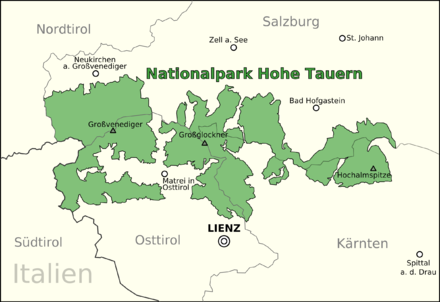Hohe Tauern National Park - national park
The Nationalpark Hohe Tauern (dead link: January 2023) is the biggest national park in Austria and one of the biggest in Europe.
Understand


The national park spans the Austrian provinces of Salzburg, Tyrol, and Carinthia. The Hohe Tauern central Alpine mountain range runs through it - approximately from the Brenner Highway in the west to the Grossglockner Hochalpenstrasse (Grossglockner High Alpine Road) in the east. The most famous mountains in the park are Austria's highest peaks, Großglockner , and the majestic, glacier surrounded Großvenediger . The park supports a large variety of wildlife and has many scenic lakes and waterfalls.
History
Member of Salzburg Provincial Parliament August Prinzinger, and the Carinthian lumber trader Albert Wirth collaborated, and in 1913, convinced the association of national parks to form a protected region that would become the core of the park. However, the park as it is known today was formed in 1971, when the governors of Tyrol, Salzburg, and Carinthia signed the agreement that led to the establishment of the park with the proper supporting legal framework.
Landscape
 Some of Austria's highest peaks, Großglockner (3,798 m above sea level) and Großvenediger (3,657 m), are in the core zone. The entire park is very mountainous with 266 mountain peaks and 250 glaciers. In the core zone, preserving ecosystems is the number one priority. The outer zone of the Hohe Tauern National Park is characterized by centuries of human activity and species-rich alpine and mountain meadows with characteristic alpine infrastructure (traditional construction methods of alpine buildings, wooden fences, stone walls, etc.).
Some of Austria's highest peaks, Großglockner (3,798 m above sea level) and Großvenediger (3,657 m), are in the core zone. The entire park is very mountainous with 266 mountain peaks and 250 glaciers. In the core zone, preserving ecosystems is the number one priority. The outer zone of the Hohe Tauern National Park is characterized by centuries of human activity and species-rich alpine and mountain meadows with characteristic alpine infrastructure (traditional construction methods of alpine buildings, wooden fences, stone walls, etc.).
Well-known sights of the national park are the Krimml Waterfalls, the Umbal Falls, the Innergschlöss Glacier Trail (Matrei in Osttirol) and the Franz-Josefs-Höhe on the Großglockner.
Flora and fauna
A third of all plant species indigenous to Austria grow here. Due to the different climatic conditions, the national park provides diverse habitats for a large number of living organisms. Edelweiss, the Wolf Lichen, White Cottongrass, and the Swiss Pine are common in the park.
The park has a breeding program for the Bearded Vulture - a bird which had once vanished from the Alps, but was reintroduced in the 1970's. The Golden Eagle, the Ibex, Chamois, and the Marmot are other creatures that thrive within the park.
Climate
Get in
From Germany you can reach the western part of the national park via the border crossing at Kiefersfelden on the A 12 (Inntal Autobahn), from the Wörgl junction via the B 312 to St. Johann, then via the B 161 over the Pass Thurn to Mittersill and on the B 108 into the national park area. Alternatively, you can travel from Salzburg via the A 10 (Tauern Autobahn) to the Bischofshofen junction and the B 311. Some destinations, such as Bad Gastein, are reachable via train (by Tauernbahn / Tauern Railway).
Fees and permits
There are no entrance fees to the park. There are a number of camp sites present throughout the region, which charge fees for camping.
Get around
See
- Krimml waterfalls. Considered to be Europe's largest waterfall, it is 380 m in height with three cascades. It is reachable from Krimml, which is in the Pinzgau valley near the edge of the national park. €4 2020-10-17
Do
- Großglockner Hochalpenstraße (Großglockner High Alpine Road). Enjoy the views from this toll road across the central alpine chain, connecting Fusch and Heiligenblut.
- Gold panning in the Rauris Valley. A community within the National Park, the Rauris Valley has a history of gold mining. Nowadays, tourists can pan for gold, with guides to help them improve their chances of finding gold. 2020-07-25
Buy
Eat
Drink
Sleep
- Chalet Charlotte, Zeller Fusch 146 (Fusch an der Großglocknerstraße), +43 69919040648. A cosy chalet holiday, comfortable, relaxed surroundings and delicious home-cooked cuisine washed down with complimentary wine ensures an unforgettable experience. A friendly, sociable atmosphere, the personal touch of your chalet hosts makes for a real 'home-from-home' atmosphere without the cooking, tidying up or cleaning! Cosy,
Lodging
Camping
Backcountry
Stay safe
Never forget that you are high on the mountains, and are subject to rapidly changing weather that can go quickly from being good to very bad. Make sure that you have adequate clothing, including rainy weather gear, and good shoes. Mountain rescuers have found that overconfidence is the most common cause of accidents. Sunscreen and plenty of water are important to have on hand.
Go next
Related Wikipedia article: Hohe Tauern#High Tauern National Park